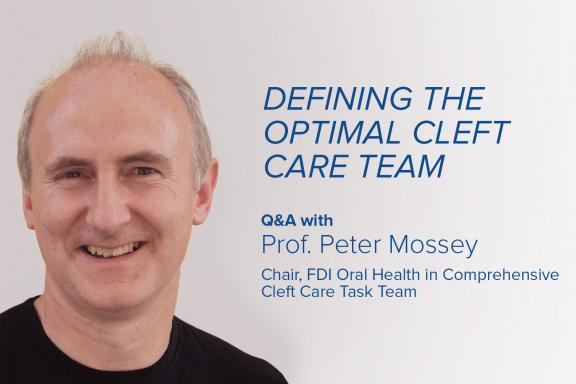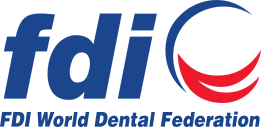The optimal outcome of cleft care is a healthy and happy, well-adjusted person who can achieve their full potential with no long-term disability or health problems: Q&A with Prof. Peter Mossey

Cleft lip and palate (clefts) are the most common birth difference of the face and mouth. Clefts occur when parts of the lip and/or palate do not fuse together during fetal development, which can lead to difficulties with feeding and even survival following birth.
Cleft lip can affect as many as 1 in 500 births, yet many children never receive the reconstructive surgery they need.
FDI spoke with Prof. Peter Mossey ahead of the talk Addressing Gaps in Global Cleft Dental Education & Care, in which he is one of the featured speakers, on 24 July from 5:00 to 6:15 PM CEST.
This session is organized by FDI and Smile Train (with support from GSK Consumer Healthcare) and will be held during the 100% virtual 2021 International Association for Dental Research (IADR) General Session from 21 to 24 July.
Prof. Mossey is the associate dean for internationalization at the University of Dundee Dental School and director of the WHO Collaborating Centre for Craniofacial Anomalies. He is the leader for the Craniofacial Anomalies theme in the WHO Global Burden of Disease Birth Defects Initiative.
He is also an expert and chair of the FDI – Smile Train Oral Health in Comprehensive Cleft Care project, which has published oral health and dental care guidelines and will soon release training programs for community dentists, cleft teams and families affected by cleft worldwide.
Below is an excerpt of our conversation.
Why is good oral health essential for the overall health of a child with cleft?
In children good health of the deciduous dentition is of tremendous importance (which is why referring to deciduous dentition as the primary dentition is a good terminology). It is very important to avoid the need for restorative procedures and to avoid dental pain and discomfort as children born with clefts have excessive exposure to medical and dental care services because of their cleft. It is also known that early loss of primary molars results in mesial drift of first permanent molars leaving insufficient space for eruption of the permanent teeth, which inevitably complicates orthodontic treatment. Such treatment may entail maxillary arch expansion which is greatly complicated if teeth are missing.
Avoiding dental decay also improves appearance of the teeth and therefore self-esteem, but most importantly adoption of good oral health and oral hygiene habits ensures the parents and children gain useful behavioural life skills.
Sugary snacks and sugar sweetened beverages are not only damaging to the dental health – they are also detrimental to overall health. Regular tooth-brushing and healthy diet are therefore part of general health and well-being, and such habits if learned young are more likely to be sustained.
This is part of the philosophy for the integration of oral health into general health using the common risk factor (CRF) approach with primary prevention of noncommunicable diseases (NCDs).
What are the consequences for a child’s oral health and overall health if they do not have timely access to cleft surgery?
Access to cleft surgery is a tremendously complex issue that pertains almost exclusively to low-resource settings, in that with high-resource settings there is generally no issue with access to timely paediatric surgery and appropriately trained multidisciplinary cleft teams.
To contrast this to the situation in low-resource settings such as India, parts of Southeast Asia (such as the Philippines and Indonesia), rural China and sub-Saharan Africa, research has revealed that the consequences of being unable to access paediatric surgical services in these countries is often death. The infant mortality rate is a result of a complex array of cultural, social and economic factors such as catastrophic expenditure, perceived burden of care and stigma in local communities.
Another concept in the developing world is the prospect of delayed surgery. This has both functional and psychological implications such as difficulties with breastfeeding at birth, plus feeding, hearing and speech and language development in the early years. Even with good cleft repairs, and in both low-middle-income countries (LMICs) and high-income country (HIC) settings, it is known that because of appearance this may result in bullying and psychological stigma, with significant psychosocial implications particularly in the late childhood and early teenage years.
Why do patients with clefts tend to have a higher risk and prevalence of dental caries?
This is a consistent finding when scrutinizing caries prevalence figures from around the world and requires further investigation. In general, the cause of dental decay is dependent on the intraoral environment to which the teeth are exposed. Where enamel demineralization exceeds remineralization, dental caries results.
Factors that contribute to the environment include less meticulous oral hygiene, dietary factors such as sugar-sweetened beverages, sugar-laden snacks such as sweets and cakes, reduced or delayed oral clearance, possibly dryer oral conditions due to mouth breathing (secondary to nasal respiratory resistance and occasionally obstructive sleep apnoea) and reduced salivary flow.
There is also a suggestion in the literature that the oral flora in cleft lip and/or palate (CLP) differs from the general population and the presence of appliances such as pre-surgical orthopaedics (PSO) and naso-alveolar moulding (NAM) could have an influence on this.
What can oral health professionals do to support patients with clefts?
It is extremely important that all members of the multidisciplinary team (MDT) looking after children with cleft are aware of the importance of good oral health. To support the maintenance of good oral health, members of the MDT are in a position of influence on dietary and hygiene behaviours. Provision of carefully worded, age-specific guidelines for oral health professionals is extremely important for ensuring that evidence-based advice is imparted throughout the treatment cycle. Of course, the primary responsibility for oral health lies with the paediatric dentist and later the orthodontist, and caries prevention measures include not only diet and hygiene but also application of fluoride and timely application of fissure sealants.
It is also important to realize the importance of secondary prevention, intervention designed to limit the severity of dental caries when it is detected early, such as use of silver diamine fluoride (SDF) and stainless steel (Hall) crowns where these are indicated. In later years the orthodontist must ensure that the intervention with appliances does not increase the risk of dental decay by introducing special hygiene measures, reinforcing dietary advice and, where indicated, using fluoride mouthwashes.
What is the value of inter-professional collaboration in terms of caring for patients with cleft? In your view what would be the ideal cleft care team?
Cleft care requires not just an MDT team approach, but very much an inter-disciplinary team approach. There is a long list of specialities involved in this, some of which are regarded as essential for every child with a cleft, such as primary surgery and for every palatal cleft, speech and language therapy, and in the case of alveolar bone grafting, orthodontics would be regarded as essential.
On the other hand, some specialities are brought in selectively according to perceived need and this would include genetics counselling; ear, nose and throat medicine (ENT) if hearing problems exist; and psychology in cleft families where this was a perceived need.
Psychological support is gradually increasing in importance and is an aspect of cleft care that should perhaps be more widely used. There is a strong case for ensuring that every child or family should be advised or provided with psycho-social counselling. The optimal outcome of cleft care is a healthy and happy, well-adjusted person who can achieve their full potential with no long-term disability or health problems.
In terms of quality of care, the best model is some form of hub and spoke model whereby the surgical service is provided at the hub and other aspects of the multidisciplinary care are provided more locally. The ideal cleft team for optimum quality of care is one where the surgeons are provided with excellent facilities, doing an agreed minimum number of procedures for proficiency, recording outcomes according to a standardized protocol in terms of timing and type of record, and prospectively registering every patient so that ongoing audit and inter-centre comparisons may be conducted. This is the best way to implement a system of evidence-based care and continuing quality improvement.
